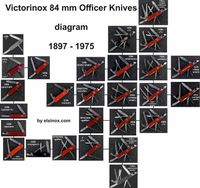84 mm officer knives
The history of the 84 mm series of "small army knives" began at the end of the 19th century. In 1897, the name "officer's and sports knife" was legally protected by Victorinox. A whole product line developed around this "big" officer's knife with various tools. Many of these original tool configurations are still available, which speaks to the success of the army knife.
At the same time, or slightly later, the series of 84 mm officer's knives appeared. As a rule, the pocket knives were given the suffix "k" for "small" in the model number. These were identical in structure and configuration to the larger 91 mm officer's knives.
In the course of history, this series of 84 mm army knives developed very successfully. There was a large number of tool combinations and models with different scale materials.
Right from the start, the army knives were one of the main attractions of the Victorinox company. The “Swiss Army Knife ” with the army knives. The name "Officer's Knife", or "Swiss Army Knife ”, suggests that these pocket knives were made for the Swiss Army, which is a mistake. The Swiss Army has never issued such officers' knives as official equipment to officers or soldiers.
Victorinox has been producing soldiers' knives for the Swiss Army since 1891, which differ significantly from the officers' knives in terms of construction and tools. It is believed that due to the success of the soldier's knife, an attempt was made to establish a connection to the army when developing these new models from 1897 onwards. It was possibly speculated that the Swiss army would also adopt these new pocket knives as official equipment. The fact that this was never the case had great advantages. In this way, Victorinox was able to develop its models freely, unhindered by specifications and restrictions, which was severely restricted in the case of the soldier's knives.
Officers are higher ranks in the army, which is why advertising and marketing explicitly referred to them right from the start. The officers' knives were intended to stand out from the soldiers' knives, which were equipped with fewer tools and seemed clumsy and bulky overall, but were sufficient for the "simple" soldier. In contrast, the officer's knives were of high quality. In these models, attempts have always been made to integrate the latest materials and tools. The officers' knives were already available with tools made of stainless steel from 1923, while this was not the case with the soldiers' knives until 1951. The officers' knives, for example, had a corkscrew to open wine bottles, which was not present on the soldiers' knives. There were also other additional tools such as scissors, saws, or toothpicks and tweezers.
At that time, officers had a reputation for being very noble, courageous and capable men. What man would not want to be associated with such attributes? This marketing certainly contributed to the success. The officers' knives continued to be marked "Armee Suisse" or " Officier Suisse" until after the 1950s, even if there was no real reference to the army, except that many members of the army certainly acquired officers' knives privately and this during the performance of their service were also allowed to use.
The series of 84 mm officer's knives was always something like the "little brother" of the "real", large 91 mm officer's knife. From the 1950s, the development of army knives was primarily concentrated on the 91 mm series, even if certain 84 mm models are still being manufactured and sold to this day, but only in a very reduced product range.
